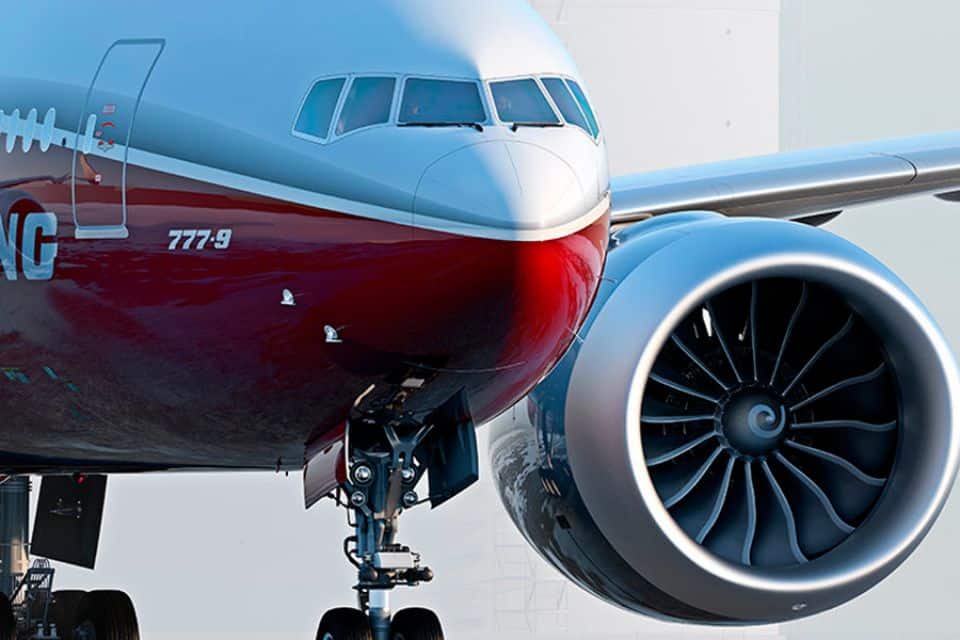Aviation
Boeing Begins Production Of The New 777X

Last week, Boeing celebrated the official kickoff of production of its 777X wide-body jet. The 777X aircraft is a large-sized twin-engine passenger aircraft currently being developed by Boeing as a successor to the existing 777, with plans for its first flight in 2019 and delivery of the first plane in 2020. Boeing’s two 777X variants, the 777-8 and 777-9, are designed to carry between 350 and 425 passengers. The new jets are expected to be 20 percent more fuel-efficient.
The ceremony brought hundreds of Boeing workers to the company’s widebody-jet manufacturing facility in Everett, Wash., where the support structures for the 777X’s CFRP composite wings are being assembled. The highlight of the ceremony was when a laser-guided robotic arm drilled a hole into the carbon fiber layer for a 105-foot-long wing spar and its stiffener and installed the first fastener. Meanwhile, in the new wing-fabrication center, an automated fiber-placement machine designed and built by Multikeo, Wash.-based Electroimpact moved along a spar mold by putting down plies of half-inch-wide carbon fiber tape to begin making a spar for the left wing of the test aircraft.
“The new 777X is going to launch into a technological era and a performance era that are not used to,” said Jason Clark, vice president of 777 and 777X operations, during the ceremony. “It’s going to set a new bar for commercial travel.”
Boeing’s Composite Wing Center will support the production of the longest wing Boeing has ever produced. The 777X features lightweight wing design based on a composite spar made of over 400 miles of carbon tape cured in a specially built autoclave. This results in a wingspan of 235 ft. Because the 777X has such a big wingspan, its wingtips have been designed to fold upward so it will fit at an airport gate.
Toray’s TORAYCA® prepreg has been selected for these main wings. Boeing will source carbon fiber prepreg composite material for the 777X’s empennage and floor beams from a new 50/50 joint venture formed last year by Solvay and Abu Dhabi-based Mubadala Development Company.
Courtesy : Composite manufacturing Magazine

Aviation
COMAC Unveils Plans for the C929 to Rival Airbus and Boeing

After the success of China’s first C919 aircraft, the country is setting its sights on developing a larger plane. COMAC (Commercial Aircraft Corporation of China) has officially confirmed plans to build a widebody aircraft, marking a significant step in its aircraft lineup.
Traditionally, Airbus and Boeing dominate the widebody aircraft market, with decades of expertise in developing planes and engines capable of carrying heavy payloads. China, which currently relies on imported engines, is now aiming to challenge these giants with its own widebody jet, the C929, designed to compete with the Airbus A350 and Boeing 777.
American Airlines Is Looking for Flight Attendants: Apply Now
The C929 will be China’s first independently developed long-range widebody aircraft. It adheres to international airworthiness standards and boasts independent intellectual property rights. The baseline version is designed to seat 280 passengers and offers a range of 12,000 kilometers, catering to global demand for both regional and international air travel.
Russia, which also needs reliable narrowbody and widebody aircraft, could become a key customer for the C929. Additionally, China plans to target the broader Asian market as it continues to expand its aviation capabilities.
Close Call at Heathrow: BA Flight Narrowly Escapes Drone Collision
China’s aviation progress includes the ARJ21 (now called C909), a regional jet with 100 seats for shorter routes, and the C919, a narrowbody jet with 180 seats designed to rival the Boeing 737 MAX and Airbus A320. Both models have found increasing demand in the domestic market.
At China’s largest air show in Zhuhai, COMAC announced that Air China will be the launch customer for the C929 widebody jet, though details about order size and delivery timelines were not disclosed.
Other major deals announced by COMAC include:
- Hainan Airlines: Firm orders for 60 C919 and 40 C909 regional jets.
- Colorful Guizhou Airlines: 30 C909 jets, with 20 firm orders and 10 provisional agreements.
The C929, renamed from the CR929 after Russia withdrew from the joint development project in 2023, is expected to carry 280–400 passengers with a range of 12,000 kilometers, competing directly with Boeing’s 787 Dreamliner.
According to COMAC’s deputy general manager, Tong Yu, the first fuselage section of the C929 is expected by September 2027, with prototype test flights anticipated soon after.
-

 Aviation2 months ago
Aviation2 months agoMicrosoft Flight Simulator Raises $3 Million to Bring Back the An-225 Mriya
-

 Airlines2 months ago
Airlines2 months agoQantas Engineers Stage Walkout Over Cost of Living Concerns
-

 Airlines2 months ago
Airlines2 months agoQatar Citizens Can Travel to the United States Without a Visa
-

 Aviation2 months ago
Aviation2 months agoQatar Airways bans these new Electronic Devices on plane
-

 Airlines2 months ago
Airlines2 months agoJapan Airlines Rolls Out Free Domestic Flights to International Passengers
-

 Defence2 months ago
Defence2 months agoWhich Country Has the Largest Fleet of Fighter Aircraft?
-

 Airport2 months ago
Airport2 months agoWestern Sydney Airport Welcomes Its First Plane After 6 Years of construction
-

 Aviation2 months ago
Aviation2 months agoDid you know ? Once Boeing 747 carried 1088 passenger in 1991








